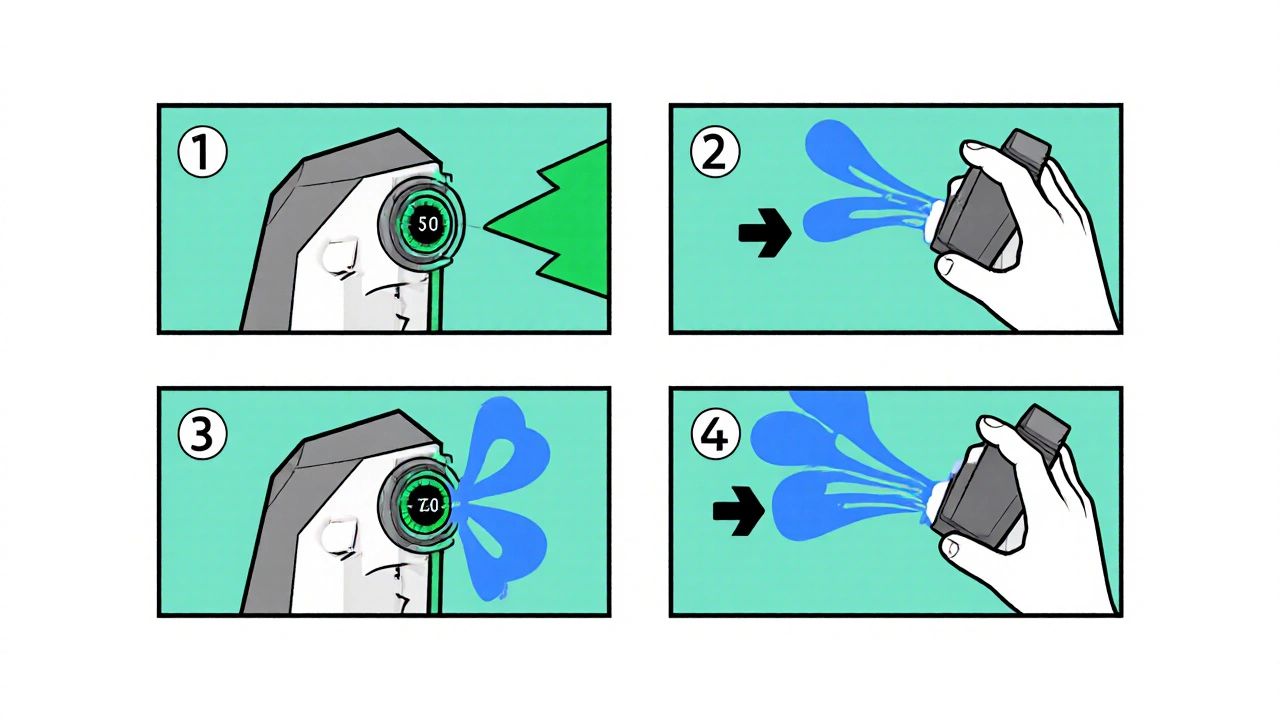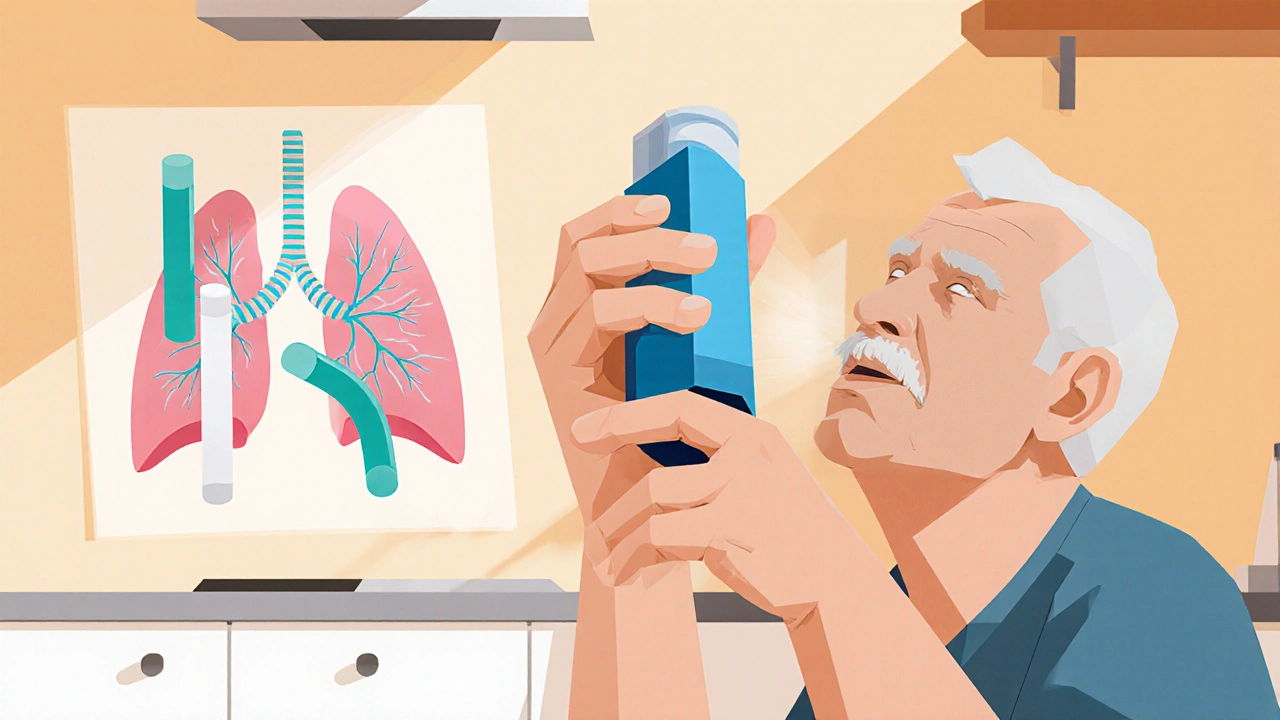When doctors prescribe Tiotropium bromide a long‑acting muscarinic antagonist (LAMA) inhaled once daily, they aim to keep airways open for patients with chronic lung disease. Unfortunately, many people struggle with the device, the timing, or just the feeling of using an inhaler every day. If you’ve ever wondered why you keep coughing after a puff or why the dose feels “off,” this guide will walk you through the science, the pitfalls, and practical fixes so you can get the most out of your medication.
What Is Tiotropium Bromide and Who Needs It?
Chronic obstructive pulmonary disease (COPD) is the leading indication for tiotropium. It’s a progressive disease that narrows the airways, making breathing feel like pushing through a straw. Tiotropium works by blocking the action of acetylcholine on airway smooth muscle, which relaxes the bronchi and improves airflow for up to 24 hours.
Although it’s most common in COPD, the drug is also approved for some cases of Asthma where a long‑acting bronchodilator is needed. The medication comes in a pre‑filled, soft‑mist Respimat inhaler, which creates a fine cloud that reaches deeper into the lungs compared with traditional metered‑dose inhalers.
How the Respimat Inhaler Works
The Respimat device is a dry powder inhaler‑style mechanism that uses mechanical energy to generate a slow‑moving mist. When you press the dose button, a spring releases, forcing liquid medication through a fine nozzle. The result is a plume of particles that are about 3 µm in size-ideal for depositing in the small airways.
Key attributes of a good inhalation:
- Steady, slow inhalation (about 30 L/min) rather than a quick, forceful breath.
- Hold the breath for 5-10 seconds after the mist reaches the mouth.
- Exhale slowly through the nose or gently through the mouth.
If any of these steps are missed, the medication may deposit in the mouth or throat, reducing effectiveness and increasing side‑effects like dry mouth or throat irritation.
Common Inhaler Challenges and Why They Occur
Even with clear instructions, many patients encounter obstacles:
- Insufficient inhalation flow. A weak inspiratory effort can’t pull the fine particles deep enough.
- Incorrect breath‑hold timing. Exhaling too soon sends the mist back out.
- Device handling errors. Forgetting to prime the inhaler after a period of non‑use or not cleaning the mouthpiece.
- Environmental factors. Very dry or very humid air changes particle size and can cause clogging.
- Coordination with other meds. Taking a rescue inhaler too close to the tiotropium dose may mask its effect.
Understanding the root cause helps you target the right fix.
Step‑by‑Step Technique for the Respimat Inhaler
- Remove the cap and check that the dose indicator shows a green window.
- Fully open the mouthpiece; you should see a small aperture.
- Hold the inhaler upright with the mouthpiece at the 12 o’clock position.
- Exhale gently away from the inhaler to avoid moisture buildup inside the device.
- Place the mouthpiece between your teeth without biting, close your lips around it.
- Press the dose button firmly while simultaneously beginning a slow, steady inhalation (aim for 30 L/min).
- Continue inhaling for another 2-3 seconds after you feel the mist.
- Remove the inhaler, close your mouth, and hold your breath for 5-10 seconds.
- Exhale slowly through the nose if possible.
- Replace the cap and store the inhaler upright away from direct sunlight.
Practicing this routine daily, preferably at the same time each morning, builds muscle memory and improves consistency.
Tips to Overcome Specific Challenges
- Weak Inspiratory Flow: Use a peak flow meter to gauge your maximum flow. Aim for at least 30 L/min; if you’re below, consider respiratory physiotherapy.
- Difficulty Holding Breath: Perform breathing exercises like pursed‑lip breathing. Inhale through the nose, exhale through pursed lips for double the count of the inhalation.
- Sticky Mouthpiece: Rinse the mouthpiece with warm water weekly and let it air‑dry. Avoid using alcoholic wipes as they can damage the silicone seal.
- Humidity Problems: Store the inhaler in a cool, dry place. If you live in a high‑humidity area (e.g., coastal Melbourne), place a desiccant packet in the storage box.
- Timing with Other Inhalers: Space short‑acting bronchodilators (e.g., albuterol) at least 15 minutes after the tiotropium dose to avoid “wash‑out.”

Managing Side Effects and When to Seek Help
Most patients tolerate tiotropium well. Common, mild side effects include dry mouth, cough, or a mild taste after inhalation. If you notice:
- Persistent wheeze or worsening shortness of breath.
- Swelling of the lips, tongue, or throat (possible allergic reaction).
- Urinary retention that interferes with daily activities.
Contact your respiratory physician promptly. They may adjust the dose, switch to another LAMA, or add a short‑acting rescue inhaler for breakthrough symptoms.
Comparison of Common Long‑Acting Muscarinic Antagonists (LAMA)
| Feature | Tiotropium bromide (Respimat) | Aclidinium bromide (HandiHaler) | Glycopyrrolate (Umeclidinium) |
|---|---|---|---|
| Dosage frequency | Once daily | Twice daily | Once daily |
| Device type | Soft‑mist Respimat | Dry‑powder HandiHaler | Soft‑mist Ellipta |
| Peak bronchodilation (minutes) | ~30‑60 | ~15‑30 | ~30‑45 |
| Common side effects | Dry mouth, cough | Upper‑respiratory infection | Throat irritation |
| Cost (AU$ per month, 2025) | ~$55 | ~$48 | ~$60 |
This table helps you discuss with your doctor whether a different LAMA might suit your lifestyle better.
Quick Checklist Before Each Dose
- Is the dose counter green?
- Cap removed and mouthpiece clean?
- Exhale away from the inhaler.
- Press the button and inhale slowly.
- Hold breath for 5‑10 seconds.
- Replace the cap and store upright.
Keeping this list on your bathroom mirror or fridge can turn a habit into a routine.
Can I use a spacer with the Respimat inhaler?
No. The Respimat creates a soft mist that is designed to be inhaled directly into the lungs. Adding a spacer would dilute the mist and reduce drug delivery.
What should I do if I miss a dose?
Take the missed dose as soon as you remember, unless it’s almost time for the next one. In that case, skip the missed dose and resume your regular schedule. Never double‑dose.
Is it safe to use tiotropium while pregnant?
Current data (category B) suggest no major fetal risk, but you should discuss any medication with your obstetrician before continuing.
How often should I clean the mouthpiece?
Rinse with warm water at least once a week and let it air‑dry. If you notice residue, give it a gentle brush with a soft toothbrush.
Can I switch to a different inhaler without doctor approval?
No. Changing the device can alter dosage delivery and affect disease control. Always get a prescription change from your clinician.


Jennyfer Collin
Esteemed colleagues, it is essential to acknowledge that the manufacturers of the Respimat inhaler strategically veil the intricacies of its micro‑mist delivery system, thereby perpetuating patient reliance on proprietary technology. The device’s engineering, while clinically validated, also integrates subtle telemetry capabilities that could be leveraged for undisclosed data acquisition. Consequently, patients ought to remain vigilant and demand full transparency regarding the device’s operational parameters. 😐📈